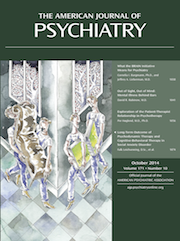T
o the E
ditor: Kimoto et al. recently reported findings from an important study that quantified glutamic acid decarboxylase 67-kDa (GAD67) and Zif268 mRNA expression in postmortem dorsolateral prefrontal cortex specimens from 62 schizophrenia subjects and 62 paired nonpsychiatric controls (
1). GAD67 and Zif268 mRNA expression levels were 14% and 32% lower on average among schizophrenia versus control subjects, though Zif268 mRNA expression levels were higher in 13 schizophrenia subjects compared with paired control subjects. In addition, GAD67 and Zif268 mRNA expression positively correlated in schizophrenia subjects (Pearson's r=0.29, p=0.027; N=58) but not controls. The authors interpreted these findings as supporting their hypothesis that decreased Zif268 mRNA expression constitutes a causal mediator of decreased GAD67 mRNA expression in schizophrenia.
Whereas the observed decreases in GAD67 and Zif268 mRNA expression are based on rigorous methods, are highly statistically significant, and were documented at different resolutions using quantitative polymerase chain reaction and in situ hybridization, some factors regarding the observed correlation between GAD67 and Zif268 mRNA expression merit consideration. First, the correlation coefficient (Pearson's r=0.29) indicates a borderline weak correlation (Pearson’s r versus correlation strength [c.]: 0.00–0.20=negligible, 0.20–0.29=weak, 0.30–0.39=moderate, 0.40–0.69=strong, 0.70–1.00=highly correlated). Undertaking sensitivity analyses might help decrease the risk of type I error. Such analyses might include nonparametric correlation tests (Spearman’s ρ), delimiting correlation tests to the schizophrenia subjects with lower Zif268 mRNA expression (N=49/62), reincluding outliers, and performing adjusted linear regressions. In addition, providing more detail on how included subjects were determined (e.g., consecutive/unselected versus convenience/selected, proportion of excluded subjects with reasons) would allow an informed assessment of selection bias risk.
The authors acknowledged that factors other than decreased Zif268 mRNA expression might also contribute to decreased cortical GAD67 mRNA expression in schizophrenia and discussed several alternative putative mechanisms. However, these alternatives did not include neuroinflammation. Neuropathological and neuroimaging studies have provided evidence implicating neuroinflammatory mechanisms in decreased cortical GAD67 mRNA expression in schizophrenia (
2). For example, one neuropathological study documented lower cortical GAD67 mRNA expression among schizophrenia subjects with high versus low proinflammatory cytokine mRNA expression (
3). The neuroinflammation model hypothesizes that prenatal insult induces microglial priming, particularly within white matter, resulting in neuroinflammation-mediated disruption of neuronal migration from periventricular germinal matrix to cortex. Thus, the neuroinflammation model maintains external validity not only with decreased cortical GAD67 mRNA expression findings but also with evidence of increased white matter neuronal density and with structural and functional white matter disconnectivity in schizophrenia, reproducible abnormalities central to neurodevelopmental and neurodegenerative hypotheses. Accordingly, neuroinflammatory mechanisms represent relevant context to the study findings.

